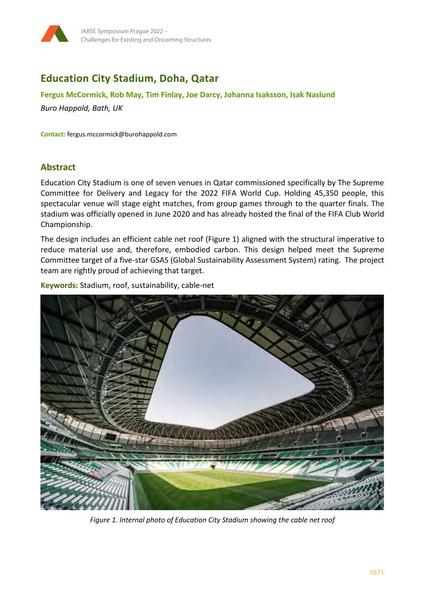Education City Stadium, Doha, Qatar

|
|
|||||||||||
Bibliographic Details
| Author(s): |
Fergus Mccormick
(Buro Happold, Bath, UK)
Rob May (Buro Happold, Bath, UK) Tim Finlay (Buro Happold, Bath, UK) Joe Darcy (Buro Happold, Bath, UK) Johanna Isaksson (Buro Happold, Bath, UK) Isak Naslund (Buro Happold, Bath, UK) |
||||
|---|---|---|---|---|---|
| Medium: | conference paper | ||||
| Language(s): | English | ||||
| Conference: | IABSE Symposium: Challenges for Existing and Oncoming Structures, Prague, Czech Republic, 25-27 May 2022 | ||||
| Published in: | IABSE Symposium Prague 2022 | ||||
|
|||||
| Page(s): | 1071-1078 | ||||
| Total no. of pages: | 8 | ||||
| DOI: | 10.2749/prague.2022.1071 | ||||
| Abstract: |
Education City Stadium is one of seven venues in Qatar commissioned specifically by The Supreme Committee for Delivery and Legacy for the 2022 FIFA World Cup. Holding 45,350 people, this spectacular venue will stage eight matches, from group games through to the quarter finals. The stadium was officially opened in June 2020 and has already hosted the final of the FIFA Club World Championship. The design includes an efficient cable net roof (Figure 1) aligned with the structural imperative to reduce material use and, therefore, embodied carbon. This design helped meet the Supreme Committee target of a five-star GSAS (Global Sustainability Assessment System) rating. The project team are rightly proud of achieving that target. |
||||
| Keywords: |
sustainability roof stadium Cable-net
|
||||
| Copyright: | © 2022 International Association for Bridge and Structural Engineering (IABSE) | ||||
| License: | This creative work is copyrighted material and may not be used without explicit approval by the author and/or copyright owner. |
||||
